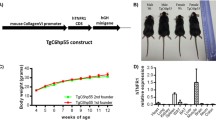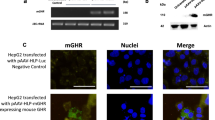Abstract
The effects of a high-growth genetic background on the growth of mice hemizygous for one of two growth hormone transgenes were examined. Male mice hemizygous for wild-type (W) and dwarf mutant (M) bovine growth hormone (bGH) transgenes were crossed with females of a high-growth selected (S) and control (C) line as follows: W x S, W x C, M x S and M x C. Body weights of progeny were recorded weekly from 2 to 10 weeks of age. F1 progeny were classified as carriers (P) or non-carriers (N) of the transgene by assaying tail DNA for bGH using the polymerase chain reaction and agarose gel electrophoresis. A deficiency in the number of f1 progeny carrying the W (P<0.05) and M (P<0.01) bGH transgene was most likely due to differential prenatal and early postnatal mortality. Bodyweight means of wild-type transgenic mice were larger (P < 0.05) than those of non-transgenic littermates by 3 weeks of age in a C background in contrast to 5 weeks in S. The wild-type bGH transgene increased adult body weights more in the C (155%) than in the S (136%) background, indicating transgene expression by selection background interaction (P < 0.05). However, the growth response to the wild-type transgene in the S background was still large. The dwarf mutant transgene had a greater effect on growth reduction in the S (70%) than in the C (84%) background, thus causing transgene expression by selection background interaction (P < 0.05). Gender by wild-type transgene effect interactions (P < 0.001) for adult body weight were caused by the transgene reducing the gender difference for body weight in C and eliminating it in S. The dwarf mutant caused a larger negative effect on growth in males than in females, resulting in a gender by dwarf mutant transgene interaction (P < 0.001) for adult body weights. Results indicate that the effect of a GH transgene on growth can be affected both by a high-growth genetic background and the gender of progeny.
Similar content being viewed by others
References
Boyd RD, Bauman DE (1989) Mechanisms of action for somatotropin in growth. In: Campion DR, Hausman GJ, Martin RJ (eds) Animal growth regulation. Plenum, New York, pp 257–293
Campbell RG, Steele NC, Caperna TJ, McMurtry JP, Soloman MB, Mitchell AD (1989) Interrelationships between energy intake and exogenous porcine growth hormone administration on the performance, body composition, and protein and energy metabolism of growing pigs weighing 25 to 55 kilograms live weight. J Anim Sci 66:1643–1655
Chen WY, Wright DC, Wagner TE, Kopchick JJ (1990) Expression of a mutated bovine growth hormone gene suppresses growth of transgenic mice. Proc Natl Acad Sci USA 87:5061–5065
Chen WY, White ME, Wagner TE, Kopchick JJ (1991) Functional antagonism between endogenous mouse growth hormone (GH) and a GH analog results in dwarf transgenic mice. Endocrinology 129:1402–1408
Davis SL (1988) Recent concepts in regulation of growth by GH and IGF. In: Current concepts of animal growth IV. J Anim Sci 66(suppl 3) 6:84–97
Eisen EJ (1975) Population size and selection intensity effects on long-term selection response in mice. Genetics 79:305–323
Etherton TD, Wiggins JP, Evock CM, Chung CS, Rebhun JF, Walton PE, Steele NC (1987) Stimulation of pig growth performance by porcine growth hormone: determination of the dose-response relationship. J Anim Sci 64:433–443
Gluckman PD, Breier BH, Davis SR (1987) Physiology of the somatotropic axis with particular reference to the ruminant. J Dairy Sci 70:442–466
Hogan B, Costantini F, Lacey E (1986) Manipulating the mouse embryo: a laboratory manual. Cold Spring Harbor Laboratory, Cold Spring Harbor, New York
Kirkpatrick BW, Rutledge JJ (1991) Genetics and transgenetics of growth. In: Pearson AM, Dutson TR (eds) Growth regulation in farm animals. Elsevier Applied Science, London, pp 47–65
Koops WJ, Grossman M (1991) Multiphasic analysis of growth curves for progeny of a somatotropin transgenic male mouse. Growth Dev Aging 55:193–202
Kopchick JJ, Cioffi JA (1991) Exogenous and endogenous effects of growth hormone in animals. Livest Prod Sci 27:61–75
Kopchick JJ, Chen WY, Shafer A, McAndrews SJ (1989) Direct DNA transfer and molecular approaches to animal growth. Rev Brasil Genet 12 (suppl):37–54
Naar EM, Bartke A, Majumdar SS, Buonomo FC, Yun JS, Wagner TE (1991) Fertility of transgenic female mice expressing bovine growth hormone or human growth hormone variant genes. Biol Reprod 45:178–187
Nagai J, Sabour MP, Benkel B (1992) Reproductive impairment in mice with the rat growth hormone transgene. J Anim Breed Genet 109:291–300
Palmiter RD, Brinster RL, Hammer RE, Trumbauer MG, Rosenfeld MG, Birnberg NC, Evans RM (1982) Dramatic growth of mice that develop from eggs microinjected with metallothionein-growth fusion genes. Nature 300:611–615
Palmiter RD, Norstedt G, Gelinas RE, Hammer RE, Brinster RL (1983) Metallothionein-human growth hormone fusion genes stimulate growth of mice. Science 222:809–814
Pomp D, Nancarrow CD, Ward KA, Murray JD (1992) Growth, feed efficiency and body composition of transgenic mice expressing a sheep metallothionein 1a-sheep growth hormone fusion gene. Livest Prod Sci 31:335–350
Pursel VG, Pinkert CA, Miller KF, Bolt DJ, Campbell RG, Palmiter RD, Brinster RL, Hammer RE (1989) Genetic engineering of livestock. Science 244:1281–1288
Sabour MP, Ramsey U, Nagai J (1991) Decreased frequency of the rat growth hormone transgene in mouse populations with or without selection for increased adult body weight. Theor Appl Genet 81:327–332
Shanahan CM, Rigby NB, Murray JD, Marshall JT, Townrow CA, Nancarrow CD, Ward KA (1989) Regulation of expression of a sheep metallothionein 1a-sheep growth hormone fusion gene in transgenic mice. Mol Cell Biol 9:5473–5474
Steel RGD, Torrie JH (1980) Principles and procedures of statistics: A biometrical approach (2nd edn) McGraw-Hill, New York
Wagner TE, Hope PC, Jollick JD, Scholl DR, Hodinka RL, Gault JB (1981) Microinjection of a rabbit beta globin gene into zygotes and its subsequent expression in adult mice and their offspring. Proc Natl Acad Sci USA 78:6376–6380
Wilkie TM, Brinster RL, Palmiter RD (1986) Germline and somatic mosaicism in transgenic mice. Dev Biol 118:9–18
Author information
Authors and Affiliations
Additional information
Communicated by G. Wenzel
Rights and permissions
About this article
Cite this article
Eisen, E.J., Fortman, M., Chen, W.Y. et al. Effect of genetic background on growth of mice hemizygous for wild-type or dwarf mutated bovine growth hormone transgenes. Theoret. Appl. Genetics 87, 161–169 (1993). https://doi.org/10.1007/BF00223760
Received:
Accepted:
Issue Date:
DOI: https://doi.org/10.1007/BF00223760




